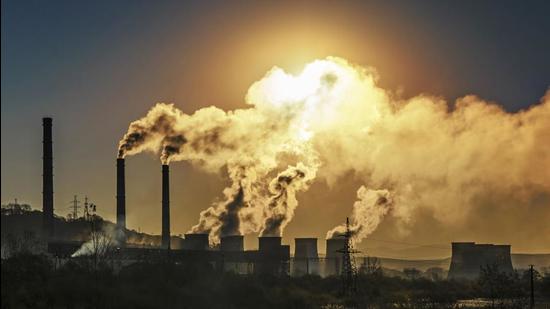COP26: Towards a meaningful outcome
Advanced countries should adopt net-zero dates earlier than 2050; Developing countries should be allowed to get there later; All countries must commit to multilateral financing
The Intergovernmental Panel on Climate Change (IPCC) warning that unless greenhouse gas emissions are sharply reduced, we will see a three-degree Celsius-plus increase in global temperatures by the end of the century, has highlighted the need for action at COP 26. There is talk of adopting a target of net-zero CO2 emissions by 2050, but this is not the best way forward.

The 2050 date comes from IPCC’s assessment that if global warming is to be limited to +1.5°C by 2100, then the carbon space available requires global CO2 emissions to decline sharply and reach net-zero by around 2050. However, this does not imply that all countries must get to net zero at the same time.
Ideally, the remaining carbon budget should be apportioned across countries fairly, reflecting “climate justice”, and each country should adopt an emission trajectory such that its total emissions would remain within its respective budget. In practice, there is no chance of any agreement on fair carbon budgets for each country. Negotiations are, therefore, likely to continue, as happened in Paris, based on voluntary commitments announced by each country. All countries will offer enhanced nationally determined contributions (NDCs) and India can certainly do the same. However, countries may also offer net-zero dates and we have to consider how India should respond.
We argue that a common net-zero date for all countries is not logical. Individual countries should indicate their enhanced NDCs and also their proposed emissions-reduction trajectory. IPCC can then compute the implications for the world of the combined individual trajectories. If they add up to an excessive level of global emissions, the next COP meeting should consider which countries must do more to reduce emissions. The advanced countries should be the ones under the greatest pressure to accelerate the transition.
This approach will require a major departure from our traditional position that we cannot consider emissions reduction. The departure is justified because our traditional argument against accepting emissions reduction was that it would compromise our growth objectives which require higher energy use, which in turn entails increased emissions. This argument no longer holds because technology now makes it possible to meet energy needs by shifting from fossil fuels to electricity wherever possible and relying on renewable sources (mainly solar and wind) to generate electricity.
We are already taking steps to achieve this transition. The railways will be fully electrified in a few years. Electric vehicles are being encouraged in private and public passenger transport and light commercial freight. There are certain areas where fossil fuel use is likely to persist but green hydrogen has great promise. It is not yet cost-competitive, but may get so in the future.
Several studies suggest that we could peak CO2 emissions in the next decade, and get to net-zero some time between 2065 and 2070. We can even do better if some of the technologies become commercially viable earlier than expected. Niti Aayog could review these studies, consult with all stakeholders including states, and come up with an acceptable emissions reduction trajectory.
Longer-term trajectories need to be supplemented with shorter-term targets that can be monitored. Phasing out of coal-based electricity is an important area. We are targeting an expanded capacity of 450 GW of RE by 2030 and this can be scaled up further in future. This also implies phasing down of coal-based power generation. We could offer a peaking of coal-based capacity before 2030, followed by a reduction thereafter.
Achieving the energy transition needed will call for massive investments. In 2009, advanced countries had promised climate finance reaching $100 billion/year by 2020. This was when the scale of the transition needed was not realised. Even this amount has not materialised, drawing criticism from developing countries, including India. However, the more important point currently is for COP26 to recognise that the scale of the transformation now envisaged calls for much larger flows.
IPCC has estimated that the developing countries will need an additional $600 billion per year. This cannot be expected to come from international assistance alone. One portion will come from domestic sources, both public and private, and another from international private flows, which will respond to market conditions and investor perceptions. A third portion can come from additional bilateral and multilateral flows. It is in mobilising the third component that the international community has a major role to play.
Amar Bhattacharya and Nicholas Stern have argued that bilateral concessional finance should be doubled and multilateral climate finance tripled by 2025, yielding $200 billion/year. These flows can stimulate private flows if imaginatively designed through risk-mitigating mechanisms.
COP26 should aim at setting credible targets for expanded lending from multilateral development banks. This will require expansion of the capital of these institutions or the use of innovative guarantee mechanisms that will allow these institutions to expand lending. A part of the new, $650 billion special drawing rights created by the IMF could be used for this purpose.
It makes sense for India to offer an emissions-reduction trajectory as part of a conditional global compact in which advanced countries adopt net-zero dates earlier than 2050 while developing countries get there later, and the global community also commits to additional bilateral and multilateral funding.
Montek Singh Ahluwalia is a distinguished fellow and Utkarsh Patel is an associate fellow, Centre for Social and Economic Progress (New Delhi)
The views expressed are personal
Continue reading with HT Premium Subscription




